Taking care of your oral health is important but have you ever thought about how your oral care routine affects the environment? The waste it produces adds to the trash in the landfills. Some products are also full of chemicals that aren't great for the earth. Plus, caring for your teeth can take lots of water. These eco dental care tips will help you keep your teeth and gums healthy while watching out for Mother Nature.
Eco-Friendly Oral Care Products
Eco dental care starts with the dental product choices you make. Buying eco-friendly products can help with waste reduction.
Toothbrushes
A traditional plastic toothbrush goes into the trash when you're done. It might be out of sight, out of mind for you, but that plastic sticks around long after you're gone. Plastic never fully decomposes. Instead, it breaks down into microplastics, which can affect the environment.
You can choose alternatives that are better for the environment. A bamboo toothbrush is an easy option. Bamboo is compostable, so you can toss the old handles in your compost bin or a municipal composting bin. It's also biodegradable if you toss it in the trash. Recycled plastic toothbrushes are also better for eco dental care.
Additionally, many electric toothbrushes have reusable handles. You simply swap out the heads, which have less plastic than a traditional toothbrush. You can also find bamboo electric toothbrushes for even more eco-friendly oral health care.
Toothpaste and Mouthwash
Your toothpaste tubes generate lots of plastic waste. Dry toothpaste options such as zero-waste toothpaste tablets and powders often come in cardboard packaging or containers made of recyclable materials like glass and metal. Many toothpaste products also contain microplastics as an abrasive ingredient. Using dry options eliminates these microplastics, which can end up in the water supply when you rinse your mouth. You can also look for natural toothpaste options that contain fewer ingredients.
Mouthwash can also cause environmental issues. Some of the chemicals can be hard on the environment, and plastic bottles create more waste. Look for a mouthwash with limited ingredients or a natural, alcohol-free mouthwash. You can also get mouthwash tablets or mouthwash products that come in refillable containers to reduce waste.
Dental Floss
Dental floss is another source of plastic waste in your oral care routine. Instead of using traditional floss, consider using a water flosser, which uses pressurized water to clean your teeth. You can also find eco-friendly floss options made from things like silk coated in natural beeswax or plant-based wax. Reusable dental floss picks can also help reduce your waste.
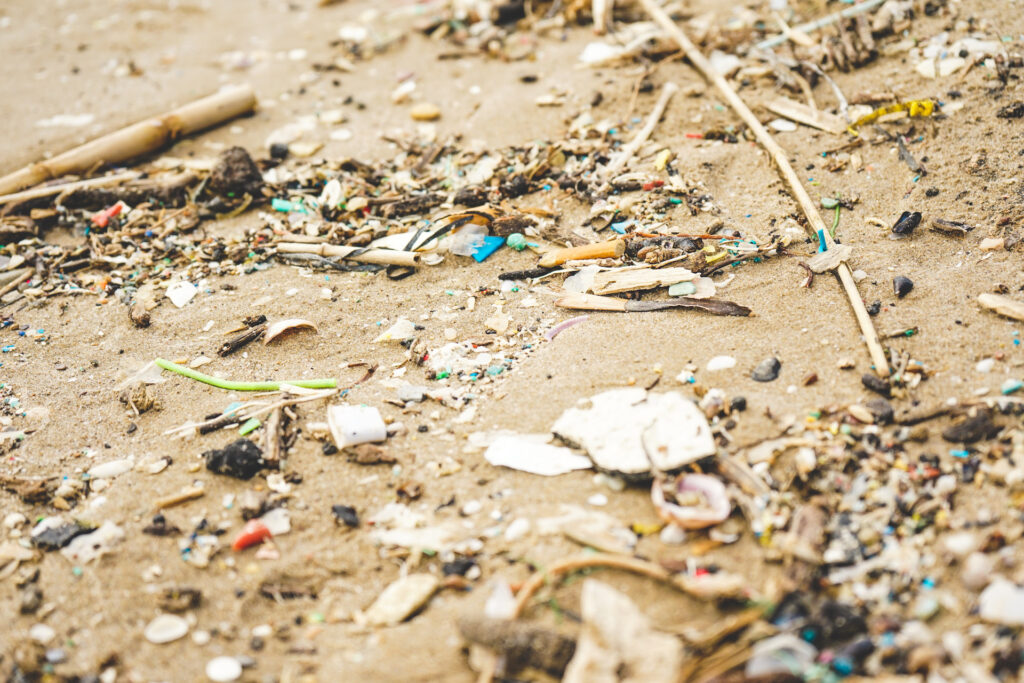
Sustainable Oral Care Practices
The way you brush your teeth can affect how eco-friendly your process is. Make these changes to create an eco dental care process.
Water Conservation
You might not think you're using much water while you're brushing but it adds up quickly if you leave the tap running. By shutting off the faucet while you brush, you could conserve about 8 gallons of water each day if you brush twice daily. If you leave the water running, collect it for other purposes such as watering plants. You can also collect extra water if you let the faucet run until it reaches the ideal temperature to reduce water waste.
Using a cup when you rinse the toothpaste can save water over using your hand to scoop water from the faucet. You capture all the water and can use it more efficiently. If you don't drink all the water, you can use it for other purposes. You can also skip the rinse after brushing your teeth. Simply spit out the excess toothpaste.
Energy Conservation
While electric toothbrushes reduce your plastic waste, they also increase your energy use. Using a manual toothbrush helps you conserve energy. If you choose an electric toothbrush, consider using one with a solar-powered charger. Turning off electronic oral care gadgets when they're not in use can also help. Don't leave your charger plugged in and running all the time if your toothbrush is fully charged.
Other Eco-Friendly Oral Care Tips
Here are some additional eco-friendly oral care tips to consider.
Choose Local and Sustainable Brands
When choosing oral care products, look for local and sustainable brands. Supporting local businesses keeps money in your community and reduces transportation emissions. Sustainable oral care companies do their part to protect the environment and make it easier for you to support environmental efforts.
Make Your Own Oral Care Products
Making oral care products at home can also protect the environment. Many DIY toothpaste and mouthwash recipes use everyday products that are safe for the environment. You can use glass containers you already have for your DIY products, or you can reuse oral care containers from products you bought at the store.
Taking Care of Your Oral Health and the Planet
Eco-friendly oral care exposes you to fewer chemicals and protects the environment. The decisions you make affect the earth, often far beyond your own community. Try eco-friendly oral care products and practices to feel better and keep your mouth healthy.
Book an appointment today to supplement your oral care routines.
Frequently Asked Questions
Is eco-friendly oral care more expensive?
Some eco dental care products might cost a little more. For instance, natural toothpaste products can be more expensive than cheap toothpaste. However, many of the products are very affordable.
Can I still have good oral health with eco-friendly products?
You can still practice effective oral hygiene with eco-friendly products. Follow recommended practices like brushing twice a day and flossing to keep your teeth healthy and avoid gum disease. Routine exams from a dental professional also help.
Where can I find eco-friendly oral care products?
Eco-friendly oral care products are available at most stores. Look in the oral care section for natural options. Your dentist can also recommend products.
Your adorable furry friend brings lots of laughs and joy to your family but they also add extra responsibility. Pet owners are usually familiar with their regular vet visit schedule. However, pet dental care might not be as familiar to fur parents but it is just as important. Just like you need routine dental care, your pets also need help with their oral health. You can support healthy teeth for your pet at home and with a professional dental checkup and cleaning. Find out more about oral hygiene for your pets.
Why Pet Dental Care Matters
As frustrating as it is to find your pup chewing on your favorite heels, those teeth are important to their health. Pet dental care is just as important as their overall health.
The Importance of Good Dental Health for Pets
Your pet needs strong, healthy teeth for eating. Healthy teeth also keep your pet feeling good and living a pain-free life. It's not always easy to tell when your pet is in pain so you might not notice if they're having oral health issues. By practicing good pet dental care, you can avoid any issues and treat things that come up quickly. Keeping up on oral health keeps your pet feeling good and acting normal.
The Risks of Neglecting Pet Dental Care
If you ignore your pet's oral health, you could face major problems including tooth decay and dental disease. Your pet might feel pain or need a tooth extraction to remove decaying teeth. These issues can make it more difficult for your pet to eat and chew on their favorite toys. But it isn't just your pet's teeth and gums that could be affected by poor oral health. Some dental problems can affect other parts of their body including the heart and liver. This can happen when bacteria from oral health issues enter your pet's bloodstream and reach other organs, potentially causing serious health issues.
Skipping regular dental care can also be costly for you. Dental health problems could result in expensive treatments to help fix the issue and relieve your pet's pain. Emergency care for a dental problem is often more expensive than scheduled vet care so you could end up paying a lot more than you would for preventative dental health care.
Keeping Your Pet's Teeth Clean and Healthy
Following regular pet dental care routines can help your pet have healthy teeth.
Tips for At-Home Pet Dental Care
Brushing your pet's teeth is one of the best ways to keep them clean and avoid issues. Regular tooth brushing helps remove plaque before it can harden into tartar and cause oral health problems. You can use human toothbrushes for larger dogs but you might need to use a baby toothbrush for smaller dogs. When you're training or rewarding your pet, use dental treats, which help deal with bad breath and remove plaque from teeth.
Diet can also play a role in your pet's dental health. Crunchy food is typically better for oral hygiene. Wet or canned food can cause more plaque buildup on your pet's teeth.
Toys and chewing objects can also affect the health of your pet's teeth. Some items such as antlers and bones can be too hard and increase the risk of a broken tooth. Even the classic tennis ball can damage the enamel of your dog's teeth. Hard rubber toys designed for dogs are easier on their teeth. If you're unsure about what type of chew toys to offer your dog, check with your vet for recommendations.
Professional Pet Dental Care
Your pet also needs a professional touch to dental care. No matter how much oral care you do at home, your pet will still likely have some plaque buildup on their teeth. Your vet should look at your pet's teeth during the annual checkup to look for any oral health problems.
If your pet has a large plaque or tartar buildup, your vet might recommend a dental cleaning that happens under general anesthesia. The frequency of these cleanings can vary depending on your pet's situation. Your vet might recommend them yearly or your pet might only need cleanings every 2 or 3 years or more. Professional dental care including dental cleanings and dental surgery should be handled by a licensed veterinarian or veterinary dentist.
Common Pet Dental Problems
Your pet is less likely to get a cavity than you are but furry family members can still have oral health issues including periodontal disease. This happens when tartar develops on the teeth. When this happens below the gumline, it can lead to infections and damage to the jawbone. Other potential dental problems include broken teeth, infections, cysts, tumors, and misalignment of the teeth.
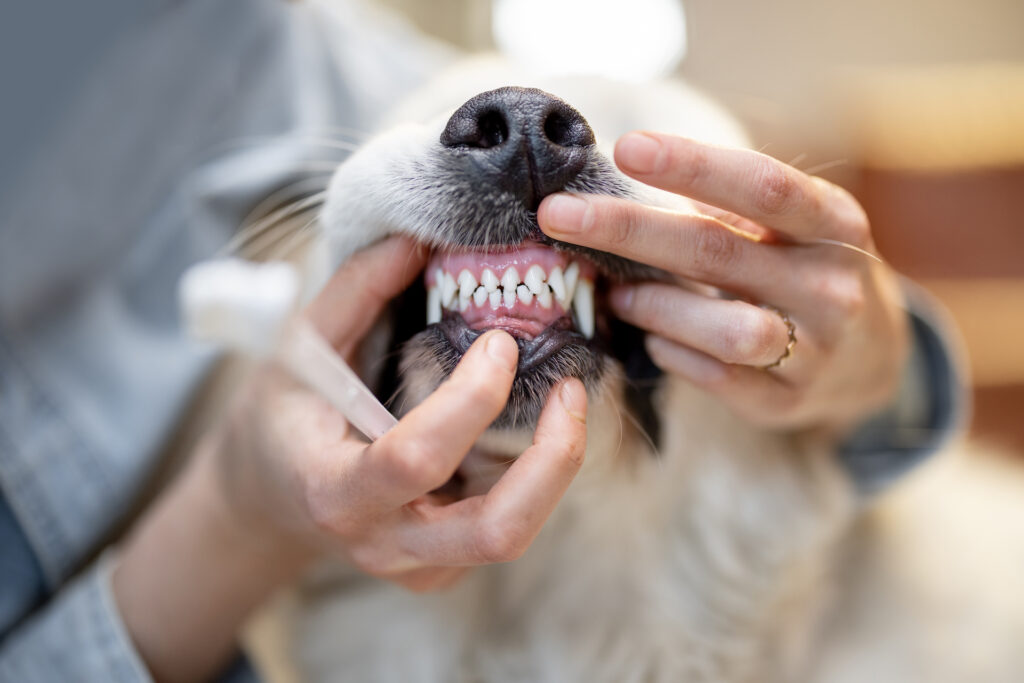
Signs of Dental Problems in Pets
Your pet can show several signs of oral health issues. Many of those symptoms are physical things you can see in your pet's mouth. Some symptoms include:
- Damage to the tooth
- Discolored teeth
- Plaque buildup
- Tooth loss
- Mouth bleeding
- Swollen gums
- Bad breath
- Drooling
Other symptoms of pet dental problems are behavioral. Your pet might become irritable or act differently in other ways. When they're eating, they might chew differently or have difficulty eating. They might avoid eating completely if their oral health issues cause them pain.
Preventing Dental Problems in Pets
Taking care of your dog's teeth regularly can help prevent dental problems such as gum disease or tooth discoloration. Home cleaning methods can reduce plaque buildup and tartar, which can prevent decay and periodontal disease. Regular dental cleaning and exams from a vet can also protect your pet's tooth health. The vet can spot early warning signs of a dental issue when it's more treatable with a simple dental procedure such as tooth extractions or deep cleanings.
Keeping Your Pet's Teeth Healthy and Strong
Pet dental care is an important part of pet ownership. Regular pet teeth brushing can help reduce plaque buildup and keep your pet's teeth and gums healthy. Home care and regular dental exam appointments can help prevent bad breath and dental health conditions that can affect your pet's quality of life. Get into a regular pet dental care routine to keep your furry friend's teeth healthy and strong.
We wish we could see your furry friends but you’ll need to schedule your pet's oral care with a vet. We would love to serve you and the rest of your family with your dental care needs though. Book an appointment today at one of our convenient locations in Arizona, Colorado, Texas, or Nevada.
Frequently Asked Questions
How often should I brush my pet's teeth?
Aim to brush your pet's teeth 2 to 3 times per week. You might need to work up to regular tooth brushing if your pet resists. If your pet enjoys having their teeth brushed, you can do it more often.
Can I use human toothpaste on my pet?
You should never use human toothpaste for your pets. They might contain toxic ingredients such as xylitol or ingredients that upset their stomach. Look for pet toothpaste, which is free of potentially dangerous ingredients.
What should I do if my pet resists dental care?
Buying pet toothpaste that's flavored like meat can make pet teeth brushing more appealing. Your pet might need several practice sessions to cooperate with oral care. With more attempts, your dog might be more willing to cooperate. Dog tooth wipes and dental chew toys can support pet dental care for uncooperative pets. Check with your vet for tips that might work with your pet. Prescription dog food that helps reduce dental disease is available and could be an option for an uncooperative pup.
When should I schedule a dental appointment for my pet?
In addition to regular professional pet teeth cleaning appointments, you should schedule a veterinary dentistry appointment if your pet shows symptoms of oral health conditions. You might need emergency care if your pet has a tooth injury or severe infection.
It can be scary to have bleeding gums after you floss, but this isn't always a sign of serious trouble. If your gums bleed when flossing, it could be a sign of common oral health issues your dentist can help with that are not as serious as gum disease. It could also simply be the way you've been flossing. Here are six of the most common causes of bleeding gums.
Bleeding gums have a lot of causes ranging from probably not a big deal to something very serious that needs to get checked. Reasons you might have bleeding gums include the following.
- Bacterial Buildup
Bacteria live all over your mouth and your gums will try to flush them out if they can. When you brush or floss, especially if you remove tartar or plaque buildup, your gums can bleed to flush the tissues and protect the site. This is more likely to happen when it's been a while since you've had a cleaning or if you have an infection causing gum inflammation. - Your Flossing Technique
Improper technique is one of the most common reasons for bleeding gums. If you're pressing too hard or scraping the surface of the gums, you can get small wounds that bleed for a bit. Brushing too hard also causes bleeding gums sometimes. Your brush might be too stiff or you could be pressing too hard for your gums, which can also cause bleeding. - Badly Fitted Appliances
Dentures and braces can both cause bleeding gums. If they're not fit quite right or if you have a loose wire somewhere, you might get a bit of blood sometimes. This is most likely to happen after you brush or floss because you might be pushing the loose bits of the braces into a soft spot on your gums. - Changes in Your Blood
Certain hormonal changes can make you more likely to bleed from the gums. Pregnant women sometimes experience bleeding gums without an obvious reason, as can people taking blood thinners and some other medications. People who have clotting disorders, such as hemophilia, might also experience bleeding gums from time to time. - Gum Disease
Gingivitis is one of the most common diseases in the world, and huge numbers of people have at least some gum irritation caused by infection or tooth decay. If you have periodontal disease like this, you might also have a puffy, red-looking gum line that aches or itches. Bleeding at odd times, not just while flossing, can also be a symptom of gum disease. - Vitamin Deficiency
Gums can bleed because you have a vitamin deficiency. Scurvy is caused by a lack of vitamin C, which is really rare in the Western world these days. Vitamin K deficiency can also show up as bleeding gums.
Is it Normal for Your Gums to Bleed?
Your gums can bleed for a lot of different reasons, and thankfully it's usually not serious. Most people experience at least occasional gum bleeding from time to time, and if there aren't other signs of trouble, it's probably not a symptom of major health issues. You're especially likely to notice some bleeding from your gums if it's been a while since you've regularly flossed or if you have tartar buildup on the gum line.
How Long Does It Take for Gums to Stop Bleeding When Flossing?
It's pretty normal for gums to bleed if you're not in the habit of flossing, but this doesn't last forever. As a rule, your gums should stop bleeding after 1-3 days of regular flossing. If your gums are bleeding for longer than this, it's a good idea to book an appointment to have a dentist take a look to make sure everything is okay.
Even if it's been a while since you fell out of the habit of daily flossing, good brushing techniques can help keep bleeding gums to a minimum. Twice-daily brushing helps promote healthy teeth, and the gentle massaging of the gum line helps stimulate healthy blood flow and firm up the gum tissue and reduce bleeding.
What's the Right Way to Floss?
There's definitely a right way to floss, which can help keep gum disease under control and reduce gum inflammation. First, pull a length of about 18 inches of dental floss and wind it around the middle fingers on each hand. Pinch the floss between your thumbs and index fingers with 1-2 inches between them. Gently work the floss between two teeth with a gentle zig-zag motion until it's seated well between the teeth, and be sure not to let it snap into the space. Bend the floss around the first tooth in a C shape and gently scour off the plaque, starting at the gum line and working outward. Floss up and down each tooth, getting the back of the teeth as well, and try to get a little under the gum line.
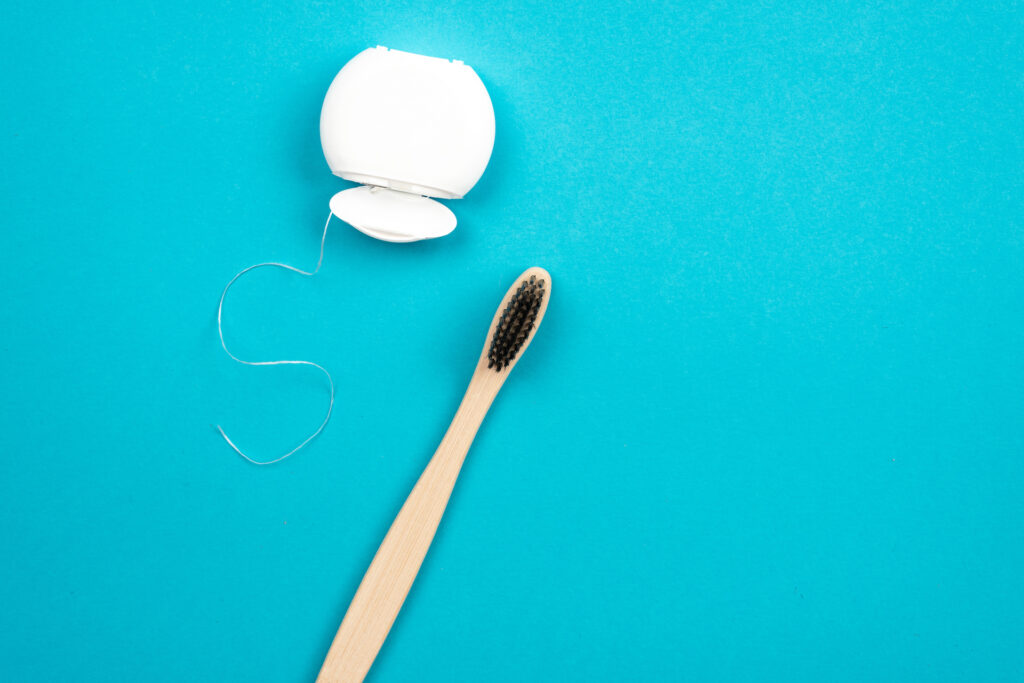
How Often Should You Floss Your Teeth?
The American Dental Association (ADA) recommends flossing at least once a day to promote good oral health and prevent gum bleeding. You can floss more often, of course, and the ADA suggests doing it right after you eat. This helps get at the plaque between teeth and fights tooth decay, bad breath, and a number of other issues like gingivitis.
Do I Have Gum Disease?
It can be hard to tell if you have gum disease, and only your dentist can tell you for sure if that's what's making your gums bleed. Symptoms of gum disease include swollen, sensitive, or bleeding gums.
How Your Dentist Can Help
Your dentist is a vital part of good gum health. Together with a dental hygienist and other teammates, your care team can give you good advice about why gums bleed, how to floss the right way, and when it's time for a professional dental cleaning.
Other Bleeding Gums Remedies You Can Try
If your gums bleed when you floss, you can try a few things to keep healthy gums. Brushing twice a day is important, along with regular flossing. Use a soft toothbrush that doesn't irritate your gums as much as a stiffer brush would, and try massaging your gums in gentle circular motions to promote healthy circulation and good gum health.
Now that you know why your gums bleed when flossing, we'd like to help you take care of your teeth. Book an appointment at one of our convenient locations so we can determine what the root cause of your bleeding gums is. We offer interest-free payment plans with no credit checks to make family dentistry easy to reach for everyone.
Frequently Asked Questions
The most common vitamin deficiencies to cause bleeding gums are vitamins C and K.
Bleeding from the gums at random times with no apparent cause might be nothing, or it could be a sign of a serious health concern. Book an appointment with a dentist without delay to discuss what might be happening.
How long it takes for gums to heal depends on how seriously they're injured. Bleeding from flossing should stop in 1-3 days, and bleeding that goes on longer than that should be looked into.
In addition to the many other health issues smoking causes, the irritating chemicals in tobacco smoke can trigger gingivitis and even loosen the gums' grip on teeth over time. This accelerates tooth decay and tooth loss, requiring restorative dentistry to fix.
Long-term stress has effects all over the body, from elevated blood pressure to a weakened immune system. This can show up as bleeding gums sometimes.
Foods containing omega-3 fatty acids, such as salmon, sesame seeds, macadamia nuts and pistachios, have anti-inflammatory properties. Because most bleeding gums are inflamed, the thinking is that omega-3 doesn't hurt, but the science is still out on how helpful it can be.
Cavities are one of the most common dental conditions in children, teens, and adults. In most cases, cavities are generally easy to treat with simple dental fillings or crowns — if they're caught in time. While it can take some time for early tooth decay to develop into a full-blown cavity, many dentists prefer that patients treat their cavities as soon as possible vs. leaving them untreated.
If you have symptoms of a cavity and you're wondering exactly how long is too long to let it go untreated, this blog post is for you! Below, you'll learn more about cavity causes, symptoms, and their overall timelines.
What Is a Cavity?
Cavities are areas of tooth decay that develop on the teeth's chewing surfaces, roots, and around dental restorations such as fillings and crowns. Tooth decay occurs when sticky plaque releases acids that erode the tooth enamel. When the sugars in the foods you eat and beverages you drink mix with the bacteria that are naturally present in your mouth, plaque can form and stick to the tooth surfaces. Over time, the acids in the plaque can damage your tooth enamel to the point where a cavity develops.
How Do You Know If You Have a Cavity?
While a common belief is that cavities are black or brown, did you know that they actually start off as white spots? Referred to as early decay, these white spots are the first sign of a pending cavity. If you notice white spots or flecks on your teeth, the good news is that this type of tooth decay can often be reversed with fluoride toothpaste and fluoride treatments.
Aside from white specks that are often so mild they go unnoticed, you might not notice any signs of a cavity in its early stages. New cavities don't usually cause any painful or uncomfortable symptoms but as they progress, you may experience tooth sensitivity or pain when biting down. You may also notice the telltale dark spots or streaks on your tooth surfaces that don't come off when you brush your teeth.
What Happens If You Don’t Treat a Cavity?
One of the most important facts about cavities is that they don't go away on their own. Even if you have a slow-growing cavity, it should be treated at some point to prevent the decay from spreading. As a cavity spreads, it affects a larger portion of the tooth. This can make it difficult to treat with a standard dental filling.
In addition to forming a large cavity, progressing tooth decay can make its way deep into the tooth and expose the tooth roots. This can be extremely painful and increase the risk of infection. In some cases, untreated cavities can cause the tooth pulp to become severely inflamed or infected.
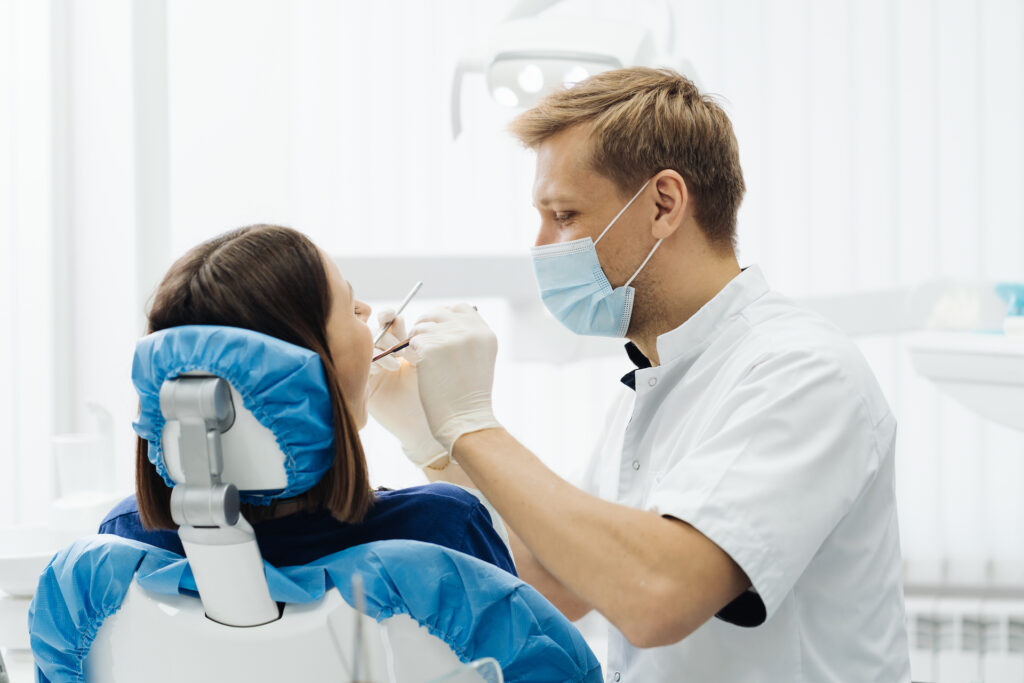
How Long Can You Delay Treatment on a Cavity Still in the Enamel?
In some cases, early signs of tooth erosion in the enamel can be successfully treated with fluoride toothpaste or surface filling materials. But once an actual cavity forms, dentists usually recommend treating it within a year. It's also important to note that timelines can vary depending on your specific dental needs. Some people have softer enamel than others, which can cause cavities to progress rapidly.
As a cavity grows, it can move from the enamel into the deeper tooth layers and eventually make its way into the pulp. The best way to determine how long you can delay treatment on an enamel cavity is to schedule a dental exam. Your dentist will take X-rays to check the size and progression of your cavity. If they feel you can wait before treatment, they'll give you an exact timeline.
How Long Can You Delay Treatment on a Cavity That Is in the Dentin?
Once a cavity begins to form in the dentin, it's important to treat it as soon as possible. The exact length of time between cavity formation in the dentin until it reaches the tooth roots can vary but this can sometimes happen in as little as 3 months. It's always best to follow the advice of your dentist when it comes to delaying treatment. They may recommend a "watch and wait" approach if the cavity has just started to form or they might suggest immediate treatment if they detect that your cavity is rapidly progressing.
How Long Can You Delay Treatment on a Cavity in the Pulp?
If your dentist diagnoses a cavity in the dental pulp, the sooner you receive treatment, the better! Pulp cavities usually require root canal treatment to prevent further damage to the tooth. During a root canal procedure, a dentist or dental specialist uses specialized tools to remove bacteria, decay, and damaged tissues from the inside of the tooth. Once the tooth is cleaned and treated, a large filling or crown is placed over the remaining tooth structure.
Causes of Cavities
Cavities develop when plaque forms on the teeth and releases acids that can eat away at the tooth enamel. The bacteria naturally present in your mouth feed on the sugars in the foods and beverages you consume, and the end result is dental plaque. Plaque is sticky, which makes it easier to adhere to tooth surfaces.
Over time, plaque releases acids that cause demineralization, also known as tooth decay. As the tooth decay progresses, the acids eat through the deeper enamel layers, causing cavities. Plaque can be very stubborn, which is why brushing at least twice a day and after meals is so important. Brushing your teeth with fluoride toothpaste can help neutralize plaque and plaque acids and lower your risk of developing cavities.

How Are Cavities Treated by Dentists?
During a cavity treatment procedure, the dentist uses a drill or other specialized dental tool to remove the decayed areas. Once the "cavity" portion of the tooth is effectively removed, the dentist fills the empty space with a metal or composite filling. For deep cavities in which a large portion of the tooth is removed, your dentist may recommend placing a dental crown to ensure the tooth surface is strong enough to withstand chewing and clenching pressure.
If you're scheduled for cavity treatment and you're worried about pain, don't be! In most cases, filling procedures aren't painful. You may feel a slight pinch when the dentist numbs your gums and the drilling can feel a little strange. Still, you shouldn't feel any pain once you're all numbed up.
If you've got a toothache or you're concerned about a potential cavity, our teammates at Risas Dental are standing by and ready to assist! We offer affordable dental care with easy payment options for all budgets and credit types. Book an appointment today.
Frequently Asked Questions
Some common dental emergencies include cracked or broken teeth, abscessed teeth, severe jaw pain, soft tissue injuries, and heavily bleeding gums. Similar to medical emergencies, a dental emergency is any situation that requires immediate treatment.
One of the most common signs of a cavity that's reached the root is throbbing pain in the affected area. You may feel pain or pressure when chewing, or your tooth might be sensitive to hot and cold. Tender, swollen gums surrounding the affected tooth are another common symptom of root cavities.
When you go for your checkup at the dentist, one of the last things you want to hear is the words "root canal." Treating a root canal isn't very fun. After all, it takes some time and causes a bit of discomfort. Still, it's essential: ignoring a root canal issue can cause the problem to spread to other areas of the mouth, leading to serious dental problems and even other potential health problems. So, how do you know if you need a root canal? Find out the seven common warning signs that root canal therapy is in your future.
What Is a Root Canal?
First, it's important to understand what a root canal is. A root canal is a type of endodontic treatment — a treatment that works on the inside of the tooth. A root canal treatment aims to repair an extremely damaged or infected tooth in the hopes of avoiding tooth removal. The treatment is called a root "canal" because the process includes cleaning out inside the canals of the roots of the tooth.
A root canal is a fairly straightforward procedure. Your dentist will extract all the bacteria from the tooth pulp, nerve, and root. Then, the area is disinfected with antibiotics and the empty roots are filled. The last step is to close the area to prevent new decay.
What Parts of the Tooth Are Involved in a Root Canal?
The root canal focuses on the inside of the tooth. With this procedure, the damaged or infected tooth pulp from inside the crown and roots of the tooth is cleaned. After the cleaning, the canal is disinfected, filled, and sealed.
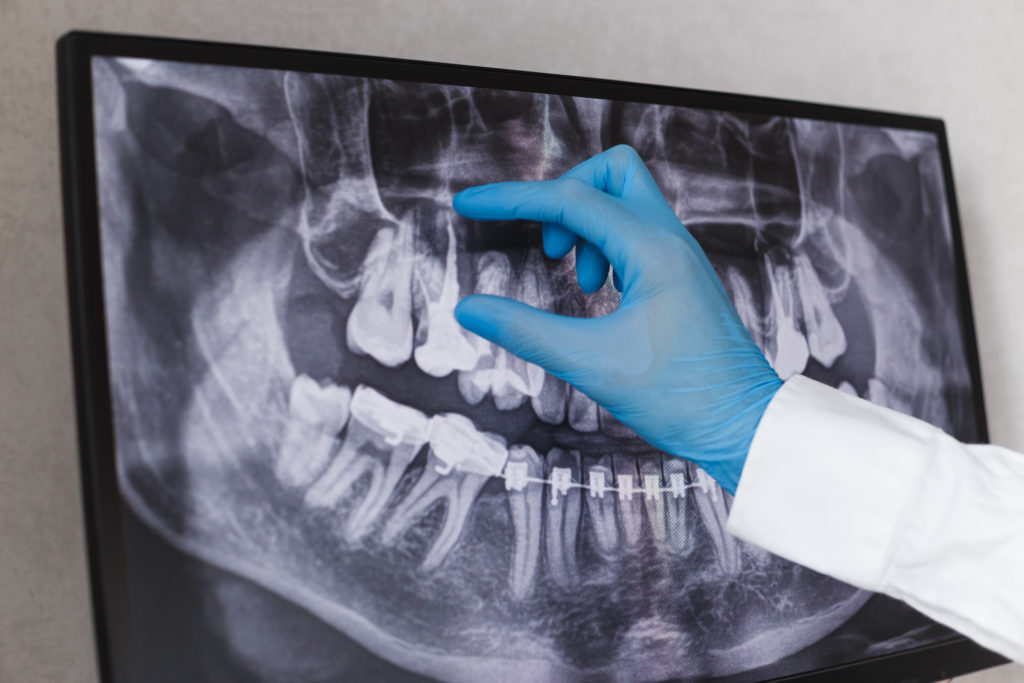
7 Signs You Need a Root Canal
Here are the seven most common signs that you may need a root canal.
- Persistent Pain
Your teeth shouldn't cause you constant pain. If you're finding that you're continuously in pain or the pain frequently bothers you, stops, and then returns, it could be a sign you need a root canal. Persistent pain can be due to a damaged root in your tooth.
Of course, persistent pain can also be due to other dental problems such as a cavity or a damaged filling. To address your tooth pain, see a dentist immediately — after all, no one wants to live with pain!
- Chipped or Cracked Teeth
When you chip or crack a tooth, it becomes more at risk for a root canal. The tooth is now "open," and bacteria can easily access the inside of the tooth, which can result in an infection. Alternatively, the tooth may have chipped or cracked in the first place because it's infected or decayed, which left it weak. Regardless, it's always a good idea to get a chipped or cracked tooth checked out by a dentist.
- Sensitivity to Heat and Cold
Believe it or not, your teeth aren't supposed to shock you with pain when you eat something cold or hot. If this happens, it could be a sign that the nerves in your teeth are damaged or infected. When your tooth's pulp chamber is infected, the nerves in the pulp chamber can overreact to heat or cold. Overreaction causes a sharp or dull pain that often lingers.
- Swollen Gums
Your gums are often a great indicator of your overall oral health. Healthy gums are firm and pink. If you notice a painful tooth has swollen gums surrounding it, this could mean you need a root canal. The swelling occurs from the acidic waste products of dead pulp tissues, and a root canal can help treat the tooth and decrease swelling in the gums.
- Tooth Discoloration
If the pulp of your tooth becomes infected, it can sometimes lead to your tooth turning a grayish-black color. A lack of blood supply to the tooth pulp can result in the breakdown of internal tissue, which might then be followed by discoloration.
Tooth discoloration doesn't always require a root canal and can instead be due to another dental problem. Regardless, you shouldn't ignore discolored teeth.
- Tooth Mobility
Tooth mobility is the medical term for a loose tooth. When a nerve is damaged, it can cause a tooth to become dislodged and feel looser. There are other reasons for tooth mobility, but root canal therapy may be necessary if you have a loose tooth.
- Deep Decay
Letting a cavity go for a long time without treatment can result in deep decay. Deep decay is when an infection has set so far into the tooth that regular oral hygiene care, or brushing and flossing, can't help. Once deep decay has set in, a root canal is often the only solution before the tooth has to be fitted with a crown.
Does a Root Canal Hurt?
Thanks to advances in modern medicine, root canals are often painless for patients. A dentist can use a combination of anesthetics and modern dental techniques, making the procedure as pain-free as possible. Patients might experience some discomfort in the tooth area for a few days post-treatment but over-the-counter pain medication can help.
Don't ignore the warning signs. If you think you might need a root canal, we recommend scheduling an appointment at one of our convenient locations.
FAQs
If you have mild symptoms, such as some slight tooth pain or sensitivity, it could mean that you just need a filling. But if you have moderate to extreme symptoms, such as tooth
discoloration, persistent tooth pain, or a loose tooth, it's far more likely you'll need a root canal. Ultimately, only a professional dentist can confirm what kind of treatment you need.
If you need a root canal, the only alternative is removing the infected tooth. According to the American Association of Endodontists, this isn't the best approach. Whenever possible, it's always best to try to save the natural tooth as an artificial tooth cannot fully replace the look or function of a natural tooth.
You might be nervous about your root canal therapy but rest assured, this is a straightforward procedure that your dentist performs regularly. There's little you need to or should do before your root canal. However, make sure you ask your dentist any questions you have so you know what to expect during and after the procedure.
No, an infected, damaged, or dying tooth cannot repair itself. Over time, the tooth will only worsen without treatment and can even spread damage to surrounding areas. Even if someone doesn't feel pain, an infected tooth should always get treated.
A root canal procedure can be performed by a regular dentist. In some cases, a more complicated case will need to be performed by an endodontist. An endodontist is a highly skilled dentist specializing in tooth pain and root canal procedures.
If an experienced dentist performs the root canal correctly, the results can last a lifetime.